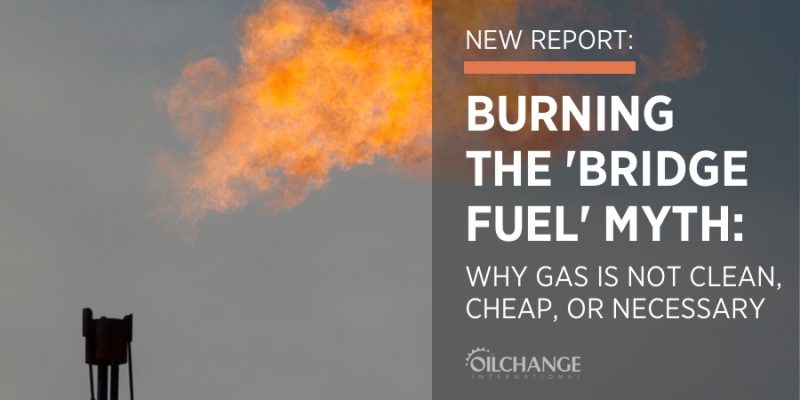
Burning the Gas ‘Bridge Fuel’ Myth: Why Gas Is Not Clean, Cheap, or Necessary
This report unpacks and debunks the enduring myth that gas can form a bridge to a decarbonized future. As the global crisis intensifies while the production and consumption of gas soars, it is clearer than ever that gas is not a solution to the climate crisis.
Published by Oil Change International.
Endorsed by 350.org, Center for Biological Diversity, Chesapeake Climate Action Network, Clean Virginia, Earthworks, Food & Water Europe, Food & Water Watch, Friends of the Earth Europe, Friends of the Earth U.S., Greenpeace USA, NC WARN, New Jersey Conservation Foundation, New York Communities for Change, Rainforest Action Network, and Sierra Club.
May 2019
DOWNLOAD REPORT
DOWNLOAD 2-PAGE SUMMARY
VIEW 2-PAGE SUMMARY IN SPANISH
DOWNLOAD SELECTED FIGURES
Key Findings and Recommendations:
This new report released by Oil Change International makes the case that gas is not a ‘bridge fuel’ to a safe climate. As the global climate crisis intensifies and gas production and consumption soars, it is clearer than ever that gas is not a climate solution. Leaking methane along the gas supply chain has been at the center of the debate around the climate impact of gas, but it’s far from the only issue at stake. There are five additional reasons why gas cannot form a bridge to a clean energy future, even if methane leakage is addressed.
These five points make clear that gas is not clean, not cheap, and not necessary:
Gas Breaks the Carbon Budget: The economically recoverable oil, gas, and coal in the world’s currently producing and under-construction extraction projects would take the world far beyond safe climate limits. Further development of untapped gas reserves is inconsistent with the climate goals in the Paris Agreement.
Coal-to-Gas Switching Doesn’t Cut It: Climate goals require the energy sector to be decarbonized by mid-century. This means that both coal and gas must be phased out. Replacing coal plants with new gas plants will not cut emissions by nearly enough, even if methane leakage is kept to a minimum.
Low-Cost Renewables Can Displace Coal and Gas: The dramatic and ongoing cost declines for wind and solar disrupt the business model for gas in the power sector. Wind and solar will play an increasing role in replacing retiring fossil fuel capacity.
Gas Is Not Essential for Grid Reliability: Wind and solar require balancing, but gas is not the only, nor the best, resource available for doing so. Battery storage is fast becoming competitive with gas plants designed for this purpose. Managing high levels of wind and solar on the grid requires optimizing a wide range of technologies and solutions, including battery storage, demand response, and transmission. There is no reason to favor gas as the primary solution.
New Gas Infrastructure Locks In Emissions: Multibillion-dollar gas infrastructure built today is designed to operate for decades to come. Given the barriers to closing down infrastructure ahead of its expected economic lifespan, it is critical to stop building new infrastructure, the full lifetime emissions of which will not fit within Paris-aligned carbon budgets.
The myth of gas as a “bridge” to a stable climate does not stand up to scrutiny. While much of the debate to date has focused on methane leakage, the data shows that the greenhouse gas emissions just from burning the gas itself are enough to overshoot climate goals.
There is an urgent need for policymakers and investors to use climate goals as a starting point for energy decisions, particularly when it comes to gas. Rather than searching for ways to justify using the abundant supply that new drilling methods have unleashed, policymakers and investors should consider how much gas is compatible with achieving the goals of the Paris Agreement. The answer is the same for gas as it is for coal and oil: We need less, not more.
CLICK HERE TO DOWNLOAD THE FULL REPORT
CLICK HERE TO DOWNLOAD A 2-PAGE SUMMARY
Key Figures: (Download)
[su_row][su_column size=”1/2″ center=”no” class=””]

[/su_column]
[su_column size=”1/2″ center=”no” class=””]
[/su_column][/su_row]

